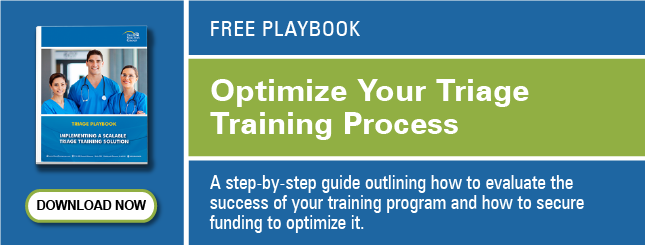 [3 MIN READ]
[3 MIN READ]
After investing in an ongoing triage training program, some emergency department (ED) managers and educators become frustrated due to gaps in the application of that education. The goal of triage is to rapidly identify and sort patients to ensure they receive the appropriate care in the right amount of time. Updated triage practice protocol and ongoing triage training helps ensure optimal patient triaging. Implementing changes though does not always come easily.
Obstacles to Implementing Triage Practice Protocol Updates
1. Practicing with providers/peers who lack knowledge of triage standards.
ED staff members who are unaware of the implementation of new triage practice protocol criteria by their organization might prevent nurses from following or adopting the new scoring system. Nurse leaders and medical directors should communicate with their staff about the new triage criteria; they should also provide the collaborative position of both ENA and ACEP on triage standards, along with the organizational policy outlining the triage scoring system selected. In addition, triage criteria reference tools such as laminated posters should be available in staff work areas.
2. Prioritizing task-directed care rather than critical thinking.
Triage decision-making should be based on critical thinking skills. However, when there is a backup in triage due to a volume surge, for example, the triage nurse needs to accomplish more in less time. This can result in a task-directed focus on triaging patients. Take the patient who is using accessory muscles to breathe as an example. The nurse using critical thinking will notice this as a red flag, whereas the nurse who is task-directed might miss the red flag because they are focusing only on completing the mandatory assessment elements (e.g., vital signs, weight, etc.). Leadership must train staff to be aware of the barriers to critical thinking at triage.
3. Refusing to accept new triage practice protocol.
This is typically motivated by the mentality of, “That’s the way we always triaged around here and it has worked for us.” In this situation, leadership should step up to enforce current and acceptable triage practices to ensure the safety of patients and the engagement of staff.
4. Concentrating on vital signs rather than identifying red flags for demise.
When a patient presents with cyanotic lips and delayed capillary refill, the nurse should not wait for vital sign results before making a triage decision. For example, in the presence of these red flags, waiting for this patient’s oxygen saturation level to see if it’s low would cause a delay in the rapid identification of a patient at great risk of demise.
Ongoing Triage Training is Essential
Another gap is created when staff focus on the completion of an ongoing triage training requirement rather than the learning experience to improve patient care. Although this is typically not the majority of staff, it is imperative to implement a process that retrospectively reviews triage records because quality care depends heavily on triage nurse decisions in high-risk situations.
Ongoing Triage Training Compliance
Triage accuracy record reviews should be coordinated to determine the level of compliance with established standards learned from ongoing triage training. As an example, an organization might pull ten records quarterly for each nurse and review for accuracy. For one quarter, the organization might look at the following:
- 2 pediatric charts, checking for the collection of weights and triage level accuracy
- 2 adult chest pain charts, checking for documentation of pain location and triage level accuracy
- 2 respiratory complaint charts, checking for perfusion elements and triage level accuracy
- 2 pediatric trauma charts, checking for perfusion and triage level accuracy
- 2 sepsis charts, checking for SIRS criteria and triage level accuracy
Within our RSQ® Solutions Triage Assessment, triage nurses retrospectively enter their own data into a system that offers critical thinking tips. While moving through a past encounter, each nurse can select the correct level to triage each patient. This provides an opportunity for individuals to identify areas of improvement in triage competency and care moving forward. Nurse managers and educators can also use the results of chart reviews to assess how individual nurses align with department policy and to guide efforts to improve performance in the triage arena.
As you evaluate your triage training options, this free playbook outlines attributes of a successful program, as well as provides ideas of where you might find funding to support an upgraded and competency assessment.


